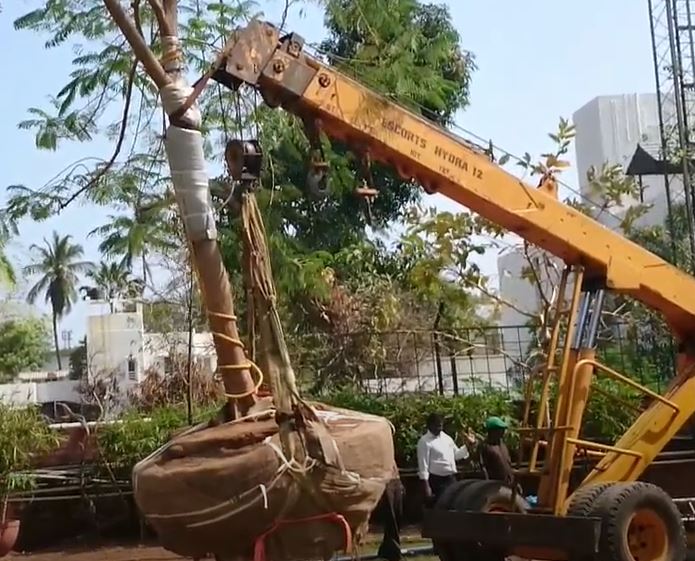Tree transplantation, also known as tree relocation or tree moving, is a sustainable practice that involves uprooting mature trees from one location and carefully transplanting them to another site. This process has gained significance in recent years due to the growing awareness of the environmental impact of urban development and the need to preserve mature trees. In this essay, we will explore the intricacies of tree transplantation, its relevance in various contexts, and the environmental benefits it offers.
The Process of Tree Transplantation:
Tree transplantation is a meticulous procedure that requires careful planning and execution to ensure the survival and thriving of the transplanted tree. The process typically involves the following steps:
- Assessment: Before initiating the transplantation process, a thorough assessment of the tree and both the original and new locations is conducted. Factors such as the tree’s health, size, and species, as well as soil conditions and environmental considerations, are taken into account.
- Preparation: The selected tree is prepared for transplantation through pruning of its roots, branches, and foliage. This step aims to reduce stress on the tree and make it more manageable for the upcoming process. Additionally, the tree’s root ball, which houses a significant portion of its root system, is carefully excavated.
- Uprooting: Specialized equipment, such as tree spades or air spades, is used to uproot the tree with minimal damage to its root system. The goal is to retain as much of the root ball as possible, ensuring the tree has the necessary resources for recovery and establishment in its new environment.
- Transportation: The uprooted tree is then transported to its new location, typically via flatbed trucks or cranes. During transportation, it is crucial to protect the tree from damage and maintain the moisture levels of the root ball.
- Replanting: Upon reaching the new site, the tree is carefully lowered into a prepared hole, and the root ball is covered with soil. Adequate staking and support may be provided to help the tree adjust to its new surroundings.
- Aftercare: Following transplantation, the tree requires careful monitoring and care. This includes regular watering, mulching, and, in some cases, fertilization to support the tree’s recovery and promote its successful establishment in its new location.
Relevance of Tree Transplantation:
Tree transplantation has become increasingly relevant for several reasons, addressing both the challenges of urban development and the need for environmental conservation.
- Urban Development and Infrastructure: As urban areas expand and undergo development, mature trees are often at risk of being removed to make way for buildings, roads, and other infrastructure. Tree transplantation offers a sustainable solution to preserve these trees, allowing for the integration of greenery into urban spaces. This not only contributes to the overall aesthetics of the area but also maintains the ecological balance.
- Biodiversity Conservation: Mature trees provide essential habitats for various species of birds, insects, and other wildlife. When these trees face the threat of removal due to urbanization, transplantation becomes a key strategy for biodiversity conservation. By relocating mature trees, we can ensure that the ecosystems they support remain intact, fostering biodiversity even in urban environments.
- Environmental Benefits: Mature trees play a crucial role in mitigating climate change by absorbing carbon dioxide and releasing oxygen. Preserving and transplanting mature trees contributes to carbon sequestration and helps combat air pollution. The transplantation process itself requires less energy and resources compared to planting new trees, making it an environmentally friendly option.
- Instant Greening of Spaces: Transplanting mature trees provides an immediate visual impact, creating instant green spaces in urban areas. This is particularly relevant in landscaping projects, where the goal is to enhance the beauty of public spaces, parks, and private developments quickly.
- Preserving Heritage Trees: Some trees carry historical or cultural significance, representing a connection to the past. Tree transplantation allows these heritage trees to be preserved and maintained, ensuring that future generations can enjoy and appreciate their cultural and historical value.
Environmental Benefits of Tree Transplantation:
- Carbon Sequestration: Mature trees are effective in absorbing and storing carbon dioxide during photosynthesis. By transplanting mature trees, we maximize their capacity for carbon sequestration, contributing to climate change mitigation.
- Oxygen Production: Trees release oxygen as a byproduct of photosynthesis. Preserving and relocating mature trees ensures a continuous and substantial supply of oxygen, improving air quality in urban areas.
- Temperature Regulation: Mature trees provide shade, reducing the urban heat island effect. Transplanting trees strategically in urban spaces helps regulate temperatures, creating more comfortable and energy-efficient environments.
- Stormwater Management: The extensive root systems of mature trees aid in water absorption and prevent soil erosion. By transplanting trees to urban areas, we can enhance stormwater management and reduce the risk of flooding.
- Wildlife Habitat Preservation: Mature trees offer diverse habitats for birds, insects, and other wildlife. Transplanting trees helps maintain these ecosystems, promoting biodiversity even in urbanized settings.
Tree transplantation emerges as a crucial tool at the intersection of urban development and environmental conservation. By preserving mature trees, we not only address the challenges of urbanization but also contribute to the well-being of the planet. This sustainable practice represents a harmonious approach to development, allowing us to build and grow while maintaining a connection to nature and fostering a healthier and more resilient environment for generations to come.
